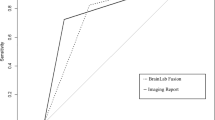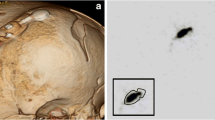Abstract
The study objective was to determine the relative diagnostic utility of the radiographic shunt series (SS), head computed tomography (CT), and nuclear imaging performed in our Emergency Department (ED) for evaluating ventricular shunt malfunction. We retrospectively reviewed medical records, head CT (if performed), and nuclear imaging (if performed) for all ED patients with suspected shunt malfunction from 2002 to 2007 who underwent plain film shunt evaluation (296 cases/186 individuals) to determine if surgical shunt revision was performed. Logistic regression analysis was applied. Four percent (12/296) of radiographic SS were abnormal. Only 0.3% (1/296) underwent surgical revision in the absence of an abnormal head CT or nuclear imaging. Eighteen percent (51/282) of head CT exams were positive and 19% (24/128) of nuclear imaging exams were positive for shunt malfunction. Twenty-three percent (67/296) underwent surgical shunt revisions. Statistical analysis demonstrated that SS evaluation was not significantly associated with surgical shunt revision (OR 0.92; 95% CI, 0.7–1.2; p = 0.47). Head CT demonstrated a significant association with surgical revision (OR 1.4; 95% CI, 1.2–1.5; p < 0.001), as did nuclear imaging (OR 1.4; 95% CI, 1.2–1.6; p < 0.001). Patients with suspected ventricular shunt malfunction frequently require surgical revision. Abnormal radiographic SS was not associated with progression to surgical shunt revision, whereas abnormal head CT and abnormal nuclear imaging were significantly associated with surgical revision. We conclude that radiographic SS in the ED is of low diagnostic utility and that patients with suspected shunt malfunction should instead initially undergo CT and/or nuclear imaging.




Similar content being viewed by others
References
Bondurant CP, Jimenez DF (1995) Epidemiology of cerebrospinal fluid shunting. Pediatr Neurosurg 23(5):254–258, discussion 259
Wu Y et al (2007) Ventriculoperitoneal shunt complications in California: 1990 to 2000. Neurosurgery 61(3):557–562, discussion 562–553
Di Rocco C et al (1994) A survey of the first complication of newly implanted CSF shunt devices for the treatment of nontumoral hydrocephalus. Cooperative survey of the 1991–1992 Education Committee of the ISPN. Childs Nerv Syst 10(5):321–327
Liptak GS, McDonald JV (1985) Ventriculoperitoneal shunts in children: factors affecting shunt survival. Pediatr Neurosci 12(6):289–293
Tuli S et al (2000) Risk factors for repeated cerebrospinal shunt failures in pediatric patients with hydrocephalus. J Neurosurg 92(1):31–38
Paulsen AH et al (2010) Twenty-year outcome in young adults with childhood hydrocephalus: assessment of surgical outcome, work participation, and health-related quality of life. J Neurosurg Pediatr 6(6):527–535
Patwardhan RV, Nanda A (2005) Implanted ventricular shunts in the United States: the billion-dollar-a-year cost of hydrocephalus treatment. Neurosurgery 56(1):139–144, discussion 144–135
Barnes NP et al (2002) Ventriculoperitoneal shunt block: what are the best predictive clinical indicators? Arch Dis Child 87(3):198–201
Garton HJ et al (2001) Predicting shunt failure on the basis of clinical symptoms and signs in children. J Neurosurg 94(2):202–210
Turhan T et al (2011) Cerebro-spinal fluid shunt revisions, importance of the symptoms and shunt structure. Turk Neurosurg 21(1):66–73
Kim TY et al (2006) Signs and symptoms of cerebrospinal fluid shunt malfunction in the pediatric emergency department. Pediatr Emerg Care 22(1):28–34
Ouellette D et al (2009) Additive value of nuclear medicine shuntograms to computed tomography for suspected cerebrospinal fluid shunt obstruction in the pediatric emergency department. Pediatr Emerg Care 25(12):827–830
Blumstein H, Schardt S (2009) Utility of radiography in suspected ventricular shunt malfunction. J Emerg Med 36(1):50–54
Desai KR et al (2007) The utility of the plain radiograph “shunt series” in the evaluation of suspected ventriculoperitoneal shunt failure in pediatric patients. Pediatr Radiol 37(5):452–456
Gilbreath PL et al (1999) Utilization and cost effectiveness review of shunt series to rule out ventriculoperitoneal shunt malfunction. Emerg Radiol 6(6):345–349
Vassilyadi M et al (2010) The necessity of shunt series. J Neurosurg Pediatr 6(5):468–473
Mater A et al (2008) Test characteristics of neuroimaging in the emergency department evaluation of children for cerebrospinal fluid shunt malfunction. CJEM 10(2):131–135
Griffey RT et al (2007) Yield and utility of radiographic “shunt series” in the evaluation of ventriculo-peritoneal shunt malfunction in adult emergency patients. Emerg Radiol 13(6):307–311
Zorc JJ et al (2002) Radiographic evaluation for suspected cerebrospinal fluid shunt obstruction. Pediatr Emerg Care 18(5):337–340
Author information
Authors and Affiliations
Corresponding author
Rights and permissions
About this article
Cite this article
Lehnert, B.E., Rahbar, H., Relyea-Chew, A. et al. Detection of ventricular shunt malfunction in the ED: relative utility of radiography, CT, and nuclear imaging. Emerg Radiol 18, 299–305 (2011). https://doi.org/10.1007/s10140-011-0955-6
Received:
Accepted:
Published:
Issue Date:
DOI: https://doi.org/10.1007/s10140-011-0955-6




